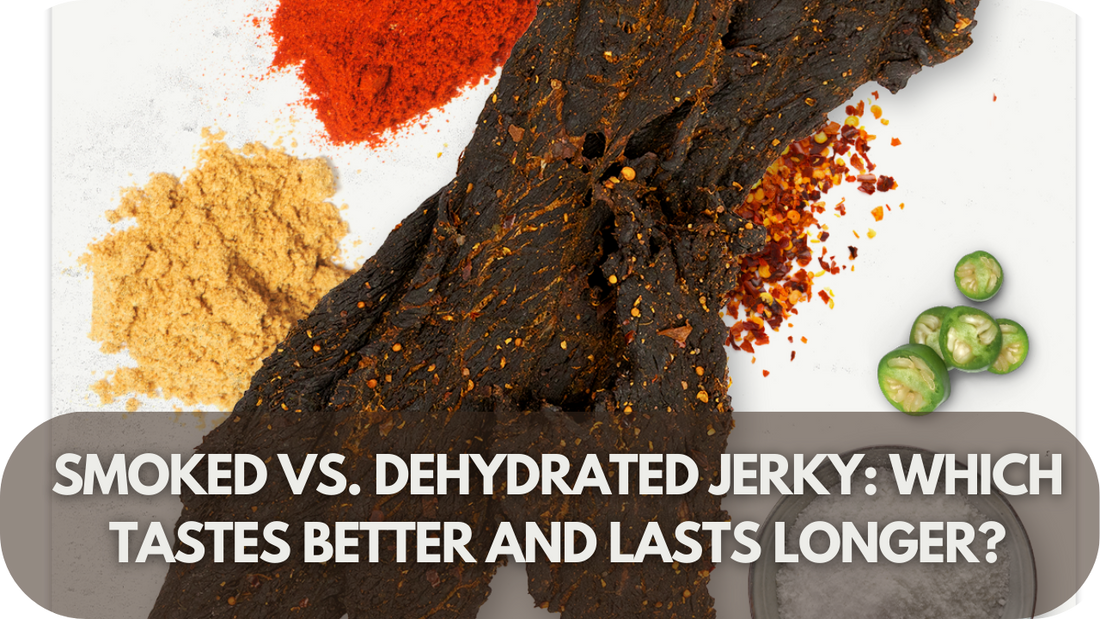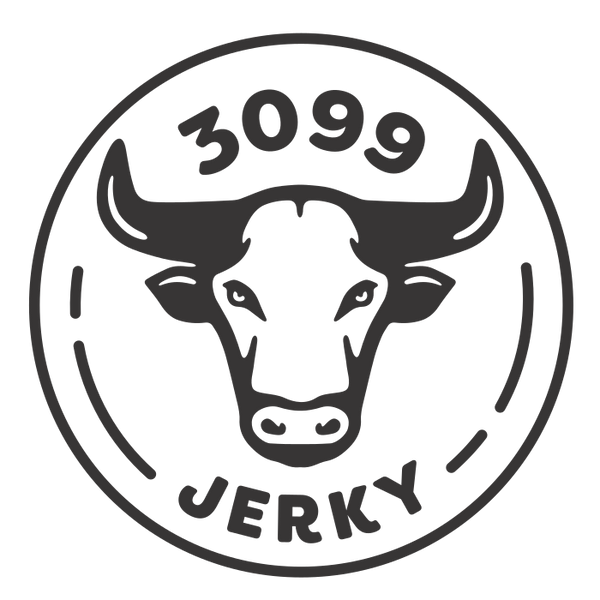
Smoked vs. Dehydrated Jerky: Which Tastes Better and Lasts Longer?
Share
Jerky lovers often debate: smoked or dehydrated— which tastes better and lasts longer? Smoked jerky has a deep, rich flavour, thanks to the wood smoke, while dehydrated jerky keeps things simple, focusing on pure meat taste.
But which method preserves jerky best? Does smoking add more flavour, or does dehydration keep it fresher for longer? This article compares taste, texture, shelf life, and overall quality. If you enjoy jerky, you’ll want to know which method is best for your next snack!
Smoked vs. Dehydrated Jerky: Which Tastes Better and Lasts Longer?
Smoked jerky delivers rich, smoky flavours from slow smoking, while dehydrated jerky offers pure, concentrated meatiness. Both last long due to low moisture, but smoked jerky’s extra preservation edge gives it a slight shelf-life advantage. Choose smoked for bold, complex tastes or dehydrated for natural meat flavours. Both are delicious, satisfying, and perfect for any snacking occasion!
What Is Smoked Jerky?
Smoked jerky is made by slowly cooking meat over wood smoke, giving it a deep, rich flavour. Unlike dehydrated jerky, which relies on heat and air circulation, smoking uses real wood like hickory, mesquite, or applewood to add a unique taste. The process takes several hours, allowing the smoke to infuse into the meat while also preserving it.
The heat from the smoke dries the meat while killing bacteria, making it safe to eat without refrigeration for a long time. Some smoked jerky is also cured with salt, which helps extend its shelf life even further.
The type of wood used affects the final taste—mesquite adds a bold, earthy flavour, while applewood gives a milder, slightly sweet touch.
What Is Dehydrated Jerky?

Dehydrated jerky removes moisture from meat using low heat and air circulation. This process prevents bacteria from growing, making the jerky safe to eat and long-lasting.
Unlike smoked jerky, which uses wood smoke for flavour, dehydrated jerky relies on seasoning, marinades, and drying techniques to enhance its taste.
A food dehydrator, oven, or even sun-drying can be used to make dehydrated jerky. The meat is sliced thin, seasoned, and then dried at a controlled temperature, usually between 50–70°C. This slow drying process can take several hours, ensuring the jerky remains chewy but not too tough.
Dehydrated jerky is often lighter and easier to bite into than smoked jerky. Because it doesn’t have the added smoke flavour, the taste depends entirely on the seasonings and marinades used. Some people prefer it for its softer texture and clean, natural meat taste.
Without smoke acting as a natural preservative, dehydrated jerky relies on proper storage to maintain freshness. When kept in airtight packaging and stored correctly, it remains flavourful for a long time. The balance of taste, texture, and shelf life makes it a popular choice for many jerky lovers.
Taste and Texture: Which Is Better?

Rich, smoky depth or a lean, chewy bite—flavour and texture define the perfect jerky experience. Every bite offers a unique sensation, shaped by the preservation method and quality of the meat.
1. Smoked Jerky
Rich, deep flavours come from the wood used in the smoking process. Hickory, mesquite, and applewood create distinct smoky notes, enhancing the savoury taste. Retaining some moisture, the texture is softer and easier to chew, with a slight tenderness that makes each bite satisfying.
The balance of smoke, seasoning, and natural meat flavour creates a bold, juicy experience. Perfect for those who enjoy a tender yet flavourful snack, smoked jerky offers a mouth-watering combination of chewiness and smokiness that keeps people coming back for more.
2. Dehydrated Jerky
Pure, concentrated meat flavour stands out without smoky undertones. The dehydration process removes almost all moisture, creating a firmer, drier, and chewier texture. This longer-lasting chew makes it a favourite for those who enjoy a more intense bite.
Seasonings shine through, as the natural taste of the meat is not overpowered by smoke. Some love the tough, satisfying texture, while others find it too dry. Ideal for long-lasting enjoyment, dehydrated jerky is the choice for those who prefer a strong, natural taste with a solid bite.
Shelf Life: Which Lasts Longer?

Preservation methods determine how long jerky stays fresh without compromising quality. Moisture levels, salt content, and storage conditions all play a role in extending shelf life while maintaining flavour and texture.
1. Smoked Jerky
The smoking process removes moisture and adds natural preservatives, but some moisture remains, allowing bacteria to develop over time.
To extend freshness, smoked jerky should be stored in an airtight container in a cool, dry place. Refrigeration increases its shelf life to 6 months, while freezing can keep it fresh for up to a year. Vacuum sealing helps maintain quality by preventing exposure to air and moisture. Smoked jerky offers rich, smoky flavours but requires careful storage for longevity.
2. Dehydrated Jerky
Dehydrated jerky lasts up to a year at room temperature and has the longest shelf life due to its extremely low moisture content. The dehydration process removes nearly all water, preventing bacteria and mould growth.
Proper storage in an airtight container away from heat and humidity ensures maximum freshness. Vacuum sealing further protects it from air exposure, extending its life. When frozen, dehydrated jerky can last beyond a year without losing texture or flavour.
Its long shelf life makes it ideal for long-term storage, outdoor adventures, and emergency food supplies while maintaining its chewy texture and rich, meaty taste.
Nutritional Differences

Both types of jerky provide a high-protein, low-carb snack packed with essential nutrients like iron and zinc. However, the preservation method affects fat content, sodium levels, and nutrient retention.
Smoking helps maintain more of the meat’s natural vitamins while adding a deep, rich flavour. It may also contain slightly more fat if not trimmed well. Dehydration, on the other hand, removes more moisture and fat, making it a leaner option.
Sodium levels can vary. Dehydrated jerky often relies on salt-heavy marinades for preservation, while smoked jerky may use less sodium since the smoke itself helps keep bacteria away. Some brands add sugar or preservatives, so checking ingredient lists is important.
Which One Should You Choose?

The choice between smoked and dehydrated jerky depends on flavour, texture, and shelf life. Both have unique qualities that make them stand out.
Smoked jerky has a deep, rich flavour from natural wood smoke. It retains more of the meat’s natural nutrients and has a slightly tender texture.
The smoking process enhances taste without needing as much salt, making it a flavourful yet balanced option. However, it may have a shorter shelf life if not stored properly.
Dehydrated jerky is drier, leaner, and lasts longer. The low moisture content helps prevent spoilage, making it ideal for long trips or emergency storage.
Since dehydration removes more fat, this type of jerky is often chewier. Some brands add extra salt or preservatives to extend freshness, so checking labels is important.
For a bold, smoky taste, smoked jerky is the best pick. If durability and a longer shelf life are the priority, dehydrated jerky is the smarter choice. Both provide a high-protein, satisfying snack, so selecting the right one depends on preference and purpose.
Conclusion
Whether you prefer the bold, smoky richness of smoked jerky or the pure, meaty essence of dehydrated jerky, both options offer unique flavours and long-lasting freshness. The choice ultimately depends on your taste preferences and snacking needs.
Ready to find out the best jerky for you? Visit 3099 Jerky today to view our premium smoked and dehydrated jerky options. Taste the difference and find your favourite – your next delicious snack is just a click away!
